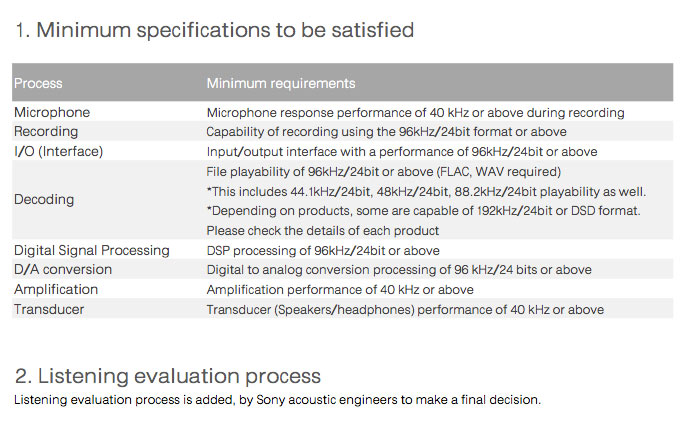The Info Graphic and JAS Logo Debacle
I feel horrible! Since my return from Las Vegas my chest and airways have been working against me…so I’m going to a doctor later this afternoon. The doctor will listen to my congested chest, prescribe some antibiotics (for probably $250) delivered by an inhaler and presto, I’ll be good as new. I hope so because I’m headed to the mountains of Montana on the 28th to spend a few days skiing with buddies at Big Sky. I haven’t been this sick in a long time and I thought plenty of rest would take care of it…no such luck.
The info graphic that came out the other day from the CEA and MusicBiz organizations needs to be revisited (it really needs to be thrown in the trash and re-imagined with correct information). You can read my post from last week here or simply read on to find just how screwed up the document really is. The elimination of MQ-C (which would have allowed CDs to be used as sources for “lossless audio that is capable of reproducing the full range of sound from recordings that have been mastered from better-than-CD music sources). How they ever managed to justify having CDs as the source to earn status as something better than a CD is the kind of logic and sense that has dominated the effort to “clarify” the whole subject. On one of the panels last week, Jim Belcher of Universal Music said high-resolution audio is “48 kHz/20-bits or better). That’s not what the JAS logo tells us.
The problem with the new info graphic is that is floats the JAS High Res Audio Logo immediately adjacent to the DEG, CEA, NARAS and label definition, which is requires vastly higher and more rigorous standards than the almost meaningless definition issued after months of conversation and hours of conference calls. You simply can’t have the logo without meeting a minimum of 40 kHz signal frequency all the way through the production chain (microphones and speakers are included). And you can’t achieve that “high-res audio” standard…the logo standard…without a sample rate of 88.2 kHz or 96 khz and word lengths of 24-bits. So why do these organization persist in trying to water down the meaning of definition?
I’ve repeated the power point page from a previous post to help make it clear.
The JAS is going to administer the logo for all interested companies. However, I didn’t notice their logo on the info graphic. I honestly wonder whether they’re actually aware of this “dumbing down” of their logo. It certainly keeps consumers and manufacturers in the dark. I won’t be surprised to see PonoMusic using the logo on its site in the near future. Where’s the integrity in any of this nonsense?
If the organizations that have opted to support the logo are doing so without meeting the standards set forth by the organization that took on the administrative role for the logo, then they should be brought in line. Lose the info graphic and get back to informing interested and anxious consumers about what’s what in the world of hi-res audio.
Take a look at the portion of the graphic below:
The committees behind this messaging said, “The terminology and categories below represent cross-industry consensus and are presented so consistent usage eliminates consumer confusion on what is Hi-Res Audio is. What could possibly be more confusing than placing the words, “HRA files are 48 khz/20-bit lossless or higher” immediately adjacent to the JAS logo that required a sample rate almost twice as high…at a minimum.
This is very troubling and should send every one of us running in the opposite direction. Maybe, and I think the percentage is much larger than 50%, the whole high-resolution audio thing is a subversive marketing ploy to extract every last dollar from audio enthusiasts for catalog that has already been sold many times over. How many of the 2.1 million CD rips on the PonoMusic website do you really want to overpay for again?
So what to do. Write to the organizations that parade this nonsense in front of us and demand that they get the facts and present them.




Where should I write ?
I would write to the people and organizations that are putting out this stuff…the CEA, the DEG, NARAS P&E Wing, MusicBiz.org etc.
“This is very troubling and should send every one of us running in the opposite direction.” In the words of the Eagles, I’m already gone! Unmitigated mess.
Mark, my maximusic Mentor, mountains of Montana might mean supplementary sources of oxygen, if pulmonary problems persist. PLEASE ask your physician. James, an anxious alumnus, Albany W.Australia
I’ve got Pneumonia. I’m glad I went to the doctor.
The graphic is about the *file*. The specifications table seems to be all about *hardware*. That’s fine, we need the right hardware, but what about the audio file and its provenance? Is that being specified? If not, the whole thing can be manipulated and disguised.
The HRA spec needs to be all about the FILE and its PROVENANCE.
The “HRA-Ready” spec can be about hardware, as per the table, but that’s not the primary issue. The primary issue is the FILE.
You nailed it. This whole enterprise comes down to whether the recording industry, artists, producers, labels, and engineers moved their productions towards more fidelity. Honestly, I have not seen any progress on that front.
would you care to comment on this product
http://www.sony.com.au/microsite/hiresaudio/
http://www.sony.com.au/microsite/hiresaudio/
They’ve done these microsites in many countries. My own website iTrax is actually one of the sources for high-res audio in the US version. They get a lot of the facts wrong but that’s marketing.
absolute deception
Just an excerpt :
“Then came the CD, which afforded high quality sound but with capacity limited by the physical size of the disc.”
Then, what/who impeded Sony/Philips to implement mono instead of stereo thereby providing 44.1 kHz frequency range limit within the 700 MB CD ?..
Mono instead of stereo…right.
Those graphics in the Sony microsite above, supposedly depicting the result of the sampling process and showing these stairstep curves are grossly misleading because they lead the naive reader to think that more samples per second is better since the curves become smoother while they can never be as perfect as the analogue original. They also serve to visualize what audio resolution supposedly is. This is far removed from the truth and does not depict the output of the ADA conversion chain. The term resolution itself when applied to digital audio (as if it were analogous to digital imaging which it isn’t) is also grossly misleading. The most appropriate term ‘fidelity’ has been unfortunately used and burned since the 50s. There’s no salvation.
You’re right…the use of graphics like these do more harm than good.
192/24 sounds more preferable over 44.1/16 at a blind testing not only because it has a better SNR but also due to a thinner layer of quantization noise within the audible range .
DVD-A’s were very often produced to sound distinguishably louder to greatly enhance the impression of higher-definition audio .
Dan Lavry had already pointed out the main reason why Upsampling gives an improvement {noted by many listeners} on fidelity of higher frequencies: some DAC intrinsic issue.
While the language is recognizably English, the real meaning (if any) is undecipherable…
Mark,
sorry to hear about your pneumonia, I hope you get well soon!
Today, for the first time I noticed their “Hi-Res Audio” in action on a commercial site: Qobuz was sending me a mail with a voucher for a free album in 48/24 (which is nice enough of them), and sure enough it sported the logo.
I won’t complain about a free album (it was a live recording of a classical concert), but I could find any information about the recording equipment and the mastering process anywhere, but I don’t think anyone would be able to distinguish this from a CD…
Best regards,
Oliver
Thanks Oliver…I’m working through it. I’d be very interested in see a screen shot of photo of the Qobuz promotion or just a link. If you want to upload a track to the FTP site, I’ll analyze it and tell everyone the deal.